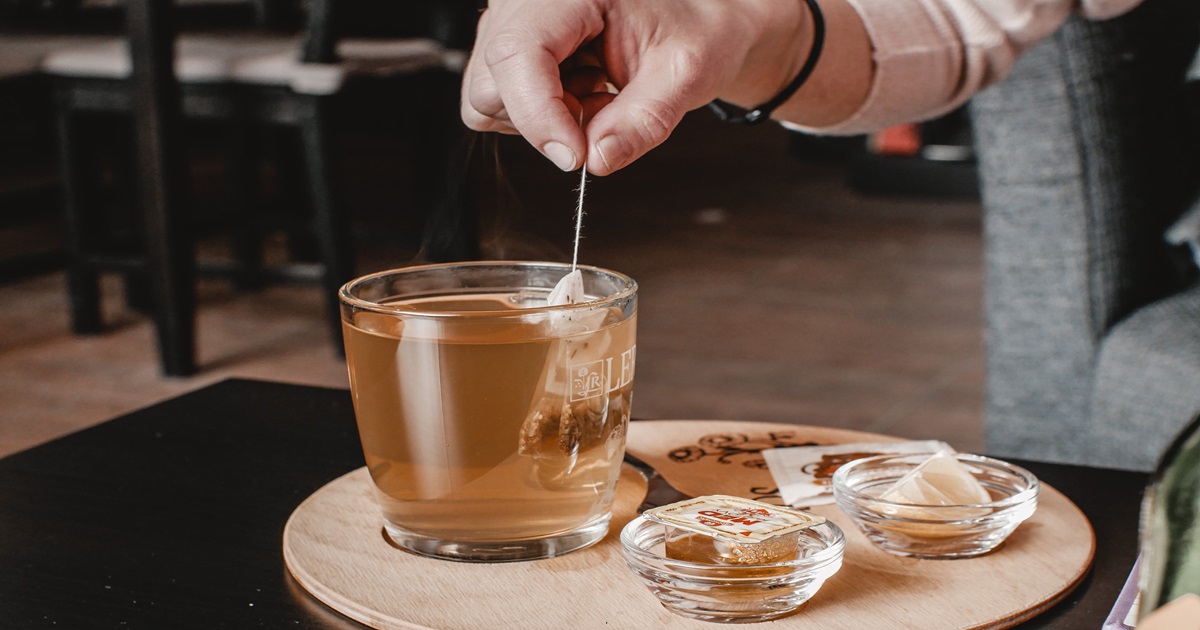Introduction: Sip to Wellness with Healthiest Herbal Teas
For generations, the world has embraced the tradition of herbal teas, valuing not only their delightful array of flavors but also the diverse health benefits they bring. Join us on this journey into the rich tapestry of herbal teas, unravelling the layers of wellness that each soothing sip can offer. Navigate through the lush landscapes of herbal blends, uncovering the natural remedies bestowed upon us by Mother Nature herself. Get ready to immerse yourself in the age-old wisdom and contemporary allure of healthiest herbal teas—comforting elixirs that transcends time for the betterment of your overall well-being. Discover the healthiest herbal teas for wellness as we explore the profound synergy of flavor and health in every cup.
Understanding Healthiest Herbal Teas: A Natural Path to Wellness
Herbal Teas: A Symphony of Nature’s Healing
Delving into the enchanting world of healthiest herbal teas opens a gateway to a symphony of natural healing orchestrated by plants. More than merely aromatic beverages, these teas are an intricate dance of flavors, fragrances, and, most importantly, the potent properties derived from the plant kingdom.
Ancient Roots, Modern Wellness
The fascinating origins of healthiest herbal teas traces back through the annals of time to ancient civilizations that recognized the therapeutic potential of plants. From traditional Chinese herbal remedies to the Ayurvedic practices of India, different cultures have embraced herbal infusions for their holistic health benefits.
A Botanical Buffet of Health
Herbal teas offer a myriad of health benefits, contributing to overall well-being. Packed with antioxidants, they combat free radicals, reducing the risk of chronic diseases. Many herbal teas possess anti-inflammatory properties, supporting joint and cardiovascular health. Improved digestion, stress relief, and enhanced immune function are common outcomes. Some herbal teas, like chamomile and peppermint, promote relaxation and aid in sleep, fostering mental and emotional balance. With minimal calories and natural compounds, these teas are a flavorful and hydrating way to boost health, making them a valuable addition to a balanced lifestyle.
Calming the Mind and Body: Chamomile Tea
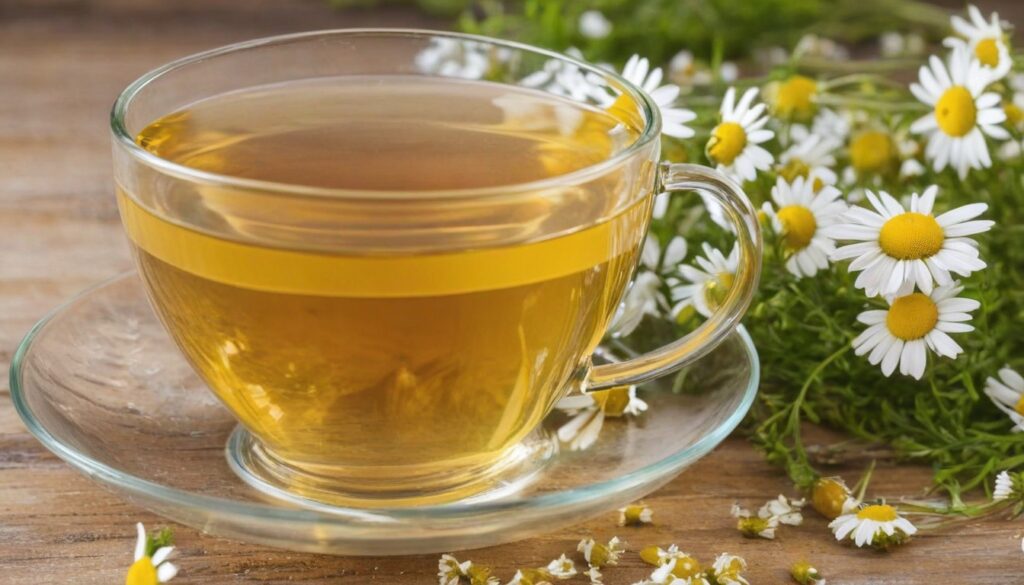
A Soothing Elixir for Relaxation and Well-Being
Renowned for its gentle and calming properties, chamomile tea stands as a time-honored remedy, offering a soothing elixir for both the mind and body. As you embark on the journey into the world of chamomile, you’ll discover a herbal infusion that transcends its delightful taste to become a holistic wellness companion.
The Origins of Chamomile: Nature’s Tranquil Gift
Chamomile tea traces its origins to ancient times, with a rich history spanning cultures worldwide. The name “chamomile” is derived from the Greek words “khamai,” meaning “on the ground,” and “melon,” translating to “apple,” referencing its characteristic apple-like fragrance. The two primary types of chamomile used for tea are German chamomile (Matricaria chamomilla) and Roman chamomile (Chamaemelum nobile). Ancient Egyptians revered chamomile for its medicinal properties, and it was later embraced by the Greeks and Romans for its calming effects. The tea gained popularity in traditional medicine across Europe and Asia, celebrated for its digestive and relaxation benefits. Today, chamomile tea remains a widely consumed herbal infusion, cherished for its soothing qualities and enjoyed for both its taste and therapeutic properties.
Relaxation in Every Sip: Chamomile’s Impact on Stress and Anxiety
Nature’s Stress Reliever
Chamomile’s ability to alleviate stress and anxiety is one of its most celebrated attributes. Chamomile interacts with neurotransmitters in a way that promotes relaxation and mitigates the impact of stress hormones. The compounds in chamomile, particularly apigenin, bind to benzodiazepine receptors in the brain. This interaction enhances the effect of gamma-aminobutyric acid (GABA), a neurotransmitter with calming properties. By modulating GABA receptors, chamomile effectively reduces neuronal excitability, leading to a calming and sedative effect. Additionally, chamomile has been shown to inhibit the release of stress-inducing hormones like cortisol. Through these mechanisms, chamomile acts as a natural anxiolytic, providing a soothing remedy for stress and promoting a sense of relaxation.
A Nighttime Companion
Chamomile’s mild sedative properties make it an excellent natural sleep aid. The herb binds to benzodiazepine receptors, enhancing gamma-aminobutyric acid (GABA) effects, promoting relaxation. This interaction, coupled with chamomile’s ability to inhibit stress hormone release, contributes to a tranquil night’s rest. Scientifically proven to improve sleep quality, chamomile is a gentle remedy for insomnia. Incorporate it into your bedtime routine by brewing a calming chamomile tea, creating a soothing pre-sleep ritual. Embrace the herb’s holistic approach to sleep, fostering a restful and rejuvenating night for improved overall well-being.
Calm for the Stomach
Chamomile extends its benefits to digestive health by soothing discomfort, easing bloating, and alleviating indigestion. Its anti-inflammatory properties and ability to relax digestive muscles make it a gentle touch for the stomach, promoting overall digestive harmony. Enjoyed before or after meals, chamomile becomes a natural remedy that not only enhances digestion but also contributes to a soothing and balanced gastrointestinal experience. Embrace the calming influence of chamomile for a digestive system that functions harmoniously, supporting your overall well-being.
Holistic Wellness with Chamomile: Beyond the Teacup
Incorporating Chamomile into Daily Wellness Practices
Chamomile’s influence reaches beyond the teacup, offering holistic wellness. Incorporate chamomile creatively into your daily routine for enhanced well-being. Indulge in aromatic chamomile baths by adding dried chamomile flowers to warm water, creating a soothing and fragrant soak. Create chamomile-infused oils by steeping chamomile in carrier oils like olive or jojoba for a calming massage experience. Blend chamomile into homemade potpourri or sachets for a refreshing and natural fragrance in your living spaces. Experiment with chamomile in culinary pursuits, infusing it into syrups or incorporating it into desserts for a subtle floral touch. These creative applications invite chamomile’s therapeutic essence into various aspects of your day, fostering a tranquil and holistic lifestyle. Uncover its potential for skin care and relaxation beyond sipping, making chamomile a versatile and cherished addition to your well-being rituals.
Boosting Immunity: Echinacea Tea
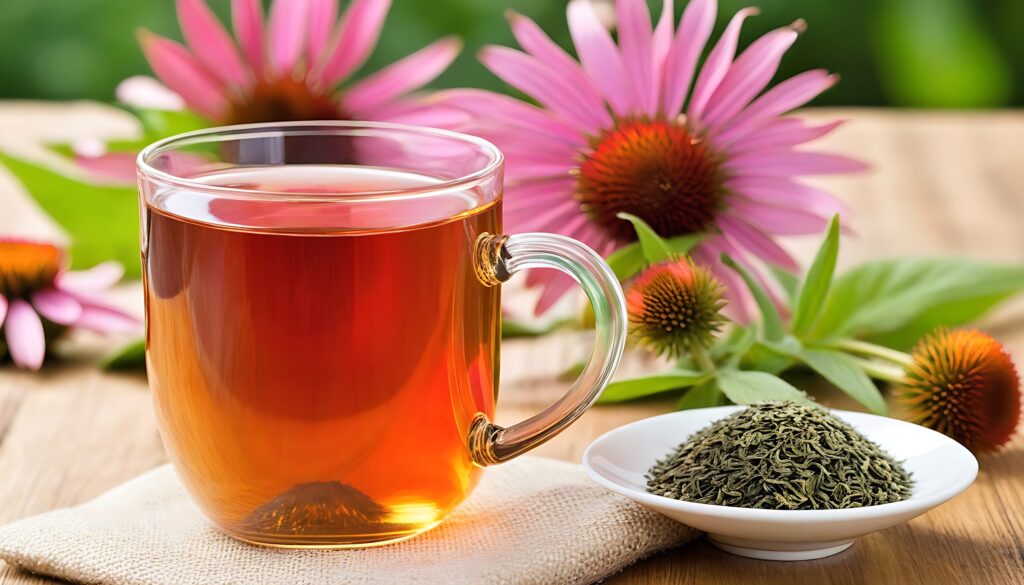
Nature’s Defense Against Illness: Unveiling the Immune-Boosting Power of Echinacea
Echinacea tea stands as a formidable shield, harnessing the potency of nature to fortify your immune system against potential threats. It is one of the healthiest herbal tea, which is renowned around the globe. Echinacea, renowned for its medicinal properties, acts as a potent immune booster. Rich in active compounds like flavonoids and alkamides, it stimulates the production of white blood cells, enhancing the body’s defense against infections. Echinacea’s anti-inflammatory and antioxidant qualities further contribute to its medicinal prowess, aiding in the prevention and alleviation of respiratory issues, common colds, and other infections. Embracing echinacea as a natural remedy fortifies the immune system, making it a valuable ally in maintaining overall health and well-being.
Antiviral and Antibacterial Properties: Echinacea’s Protective Shield
Guarding Against Pathogens
Echinacea, a flowering plant native to North America, is renowned for its immune-boosting properties, acting as a protective shield against infections. The plant contains active compounds like alkamides and polysaccharides that stimulate the immune system by promoting the production of white blood cells, which play a key role in fighting off pathogens. Echinacea is believed to enhance the activity of macrophages, the cells responsible for engulfing and digesting harmful microorganisms. Additionally, it may increase the production of interferons, signaling proteins that help regulate the immune response. By fortifying the body’s natural defense mechanisms, Echinacea is thought to create a protective barrier, reducing the severity and duration of infections and supporting overall immune health.
The Importance of Regular Consumption: Cultivating Immune Resilience
Making Echinacea Tea a Daily Ritual
Incorporating Echinacea tea into your daily ritual holds paramount importance for immune support. Echinacea’s active compounds stimulate white blood cell production, bolstering the body’s defense against infections. Regular consumption may enhance immune response, potentially reducing the risk and severity of illnesses. As a daily ritual, Echinacea tea serves as a proactive measure, creating a protective shield that fortifies your immune system. Its natural and soothing qualities make it an accessible and enjoyable way to prioritize your well-being, contributing to overall health and resilience in the face of common health challenges. Here’s how you can make it your daily rituals:
1. Echinacea Infusion:
- Boil water and steep dried echinacea leaves or tea bags for 5-7 minutes.
- Add honey or lemon for flavor, if desired.
2. Echinacea Blend:
- Combine echinacea with other herbs like peppermint or chamomile for a customized blend.
- Steep in hot water and strain for a harmonious infusion.
3. Echinacea and Citrus Cold Brew:
- Mix echinacea tea with cold water and refrigerate overnight.
- Add citrus slices for a refreshing, immune-boosting cold brew.
4. Echinacea Iced Tea:
- Brew a strong batch of echinacea tea, then cool.
- Serve over ice with a splash of fruit juice for a revitalizing iced tea.
5. Echinacea Honey Infusion:
- Mix echinacea tea with honey and let it infuse for added sweetness and immune benefits.
- Stir into hot water or add to herbal blends.
Experiment with these methods to find your preferred way to enjoy the immune-boosting benefits of echinacea.
Considerations and Precautions: Echinacea’s Safe Guardianship
While Echinacea tea offers immune benefits, it’s crucial to exercise caution regarding dosage. As with any herbal remedy, moderation is key. Prolonged, excessive consumption may lead to potential side effects, including nausea or allergic reactions. It’s advisable to adhere to recommended brewing guidelines and not exceed the suggested daily intake. Pregnant or breastfeeding individuals, those with autoimmune disorders, or on immunosuppressive medications should consult a healthcare professional before incorporating Echinacea tea into their routine. Additionally, using Echinacea intermittently, rather than continuously, may help prevent a diminishing effect over time. Responsible use ensures the tea remains a supportive component of a balanced lifestyle without undue risk.
Digestive Harmony: Peppermint Tea

A Deep Dive into the Soothing Powers of Peppermint Tea
Peppermint tea, derived from the aromatic leaves of the peppermint plant (Mentha × piperita), boasts a refreshing flavor and a spectrum of health benefits. The tea is celebrated for its ability to soothe digestive issues, offering relief from indigestion and bloating. Peppermint tea’s menthol content provides a natural decongestant, easing respiratory discomfort. Additionally, it acts as a mild muscle relaxant, alleviating tension headaches and promoting relaxation. With its calming properties, it serves as an excellent choice for stress reduction and improved sleep. Whether enjoyed hot or cold, peppermint tea stands out not only for its delightful taste but also as a versatile and health-promoting beverage.
Peppermint’s Digestive Efficacy: Nature’s Antidote to Discomfort
Peppermint tea is not only a delightful and refreshing beverage but also a powerhouse of health benefits, making it one of the healthiest herbal teas. Known for its distinctive flavor and aroma, this herbal infusion has been cherished for centuries across cultures. From aiding digestion to offering relief from headaches and promoting relaxation, peppermint tea is a versatile elixir that goes beyond its flavorful appeal. Let’s explore the numerous ways in which incorporating peppermint tea into your routine can contribute to your overall well-being.
- Digestive Aid: Eases indigestion, bloating, and gas, promoting overall digestive comfort.
- Relief for Nausea: Helps alleviate nausea and motion sickness due to its soothing properties.
- Respiratory Support: Acts as a natural decongestant, relieving sinus congestion and promoting easier breathing.
- Headache Relief: Contains menthol, which may ease tension headaches and migraines by acting as a muscle relaxant.
- Stress Reduction: Its calming properties can help reduce stress and anxiety, promoting relaxation.
- Improved Sleep: A caffeine-free option, peppermint tea can be a soothing bedtime beverage, aiding in better sleep.
- Antioxidant Properties: Rich in antioxidants, it helps combat free radicals and supports overall health.
Incorporating peppermint tea into your routine offers a flavorful way to address various health concerns and enhance well-being.
Taking Peppermint tea as a daily routine
You can prepare pepper mint tea in various ways to get the most of it’s health benefits. Here are some ways you can incorporate it to your daily routine.
1. Classic Peppermint Infusion:
- Steep fresh or dried peppermint leaves in hot water for 5-7 minutes.
- Strain and enjoy the pure, refreshing taste of peppermint tea.
2. Peppermint and Green Tea Blend:
- Combine peppermint leaves with green tea for a revitalizing blend.
- Steep both teas together for a delightful fusion of flavors.
3. Peppermint and Lemon Cold Brew:
- Mix peppermint tea with cold water and refrigerate overnight.
- Add a splash of lemon for a cool and invigorating cold brew.
4. Peppermint Chai Infusion:
- Blend peppermint with chai spices like cinnamon and cardamom.
- Steep in hot milk for a spicy and aromatic peppermint chai.
5. Peppermint and Lavender Infusion:
- Combine peppermint and dried lavender for a floral twist.
- Steep for a calming infusion that balances minty freshness with subtle floral notes.
6. Peppermint and Ginger Brew:
- Infuse peppermint with fresh ginger for a soothing and digestive-friendly tea.
- Add honey for sweetness and extra flavor.
Explore these versatile ways to enjoy peppermint tea, whether hot, cold, or blended with complementary herbs and spices.
Antioxidant-Rich Delight: Green Tea Blends
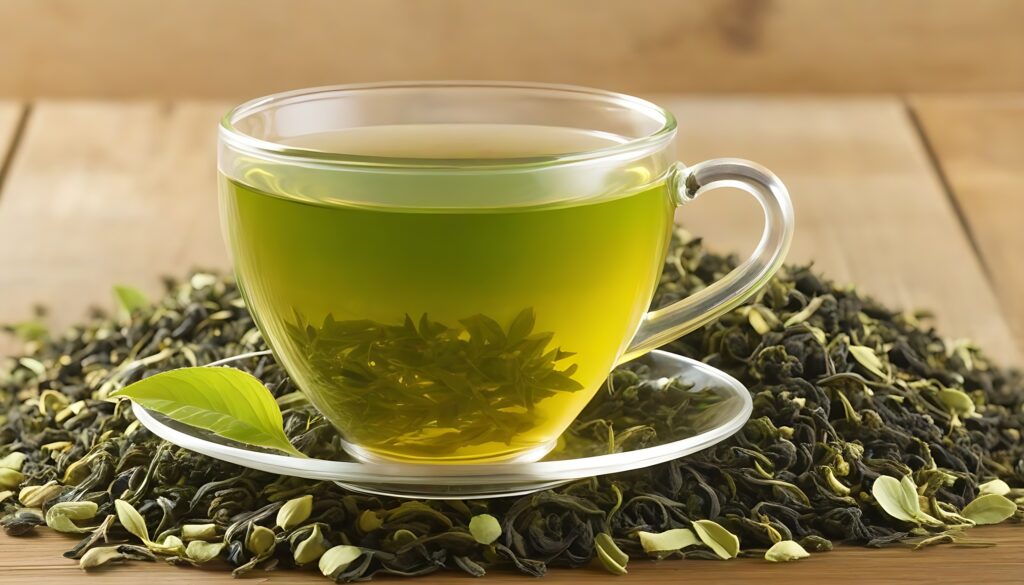
Harnessing Nature’s Antioxidants: A Journey into the Healthful World of Green Tea Blends
Green tea blends combine the health benefits of traditional green tea with an array of complementary flavors, herbs, and botanicals, offering a diverse and enjoyable tea-drinking experience. Popular blends often include ingredients like mint, jasmine, ginger, citrus, or fruits, enhancing the tea’s taste profile. For instance, green tea with mint provides a refreshing and invigorating twist, while jasmine-infused green tea offers a fragrant and floral note. These blends not only cater to individual preferences but also provide added health benefits. The combination of green tea’s antioxidants with the unique properties of the added ingredients may boost metabolism, improve digestion, or provide relaxation. With a spectrum of flavors to choose from, green tea blends cater to diverse palates, making the ritual of tea consumption both a sensory delight and a healthful experience.
Green Tea’s Antioxidant Arsenal: The Power of Catechins and Polyphenols
Green tea blends, infused with various herbs, fruits, and spices, offer a delightful fusion of flavors while maintaining the health benefits of traditional green tea. These blends often provide:
- Enhanced Antioxidant Power: Green tea’s inherent antioxidants, combined with those from added ingredients like berries or citrus, contribute to a potent free-radical-fighting brew.
- Metabolism Boost: Blends with ingredients such as ginger or mint may support metabolism, aiding in weight management and energy levels.
- Digestive Support: Certain blends, incorporating herbs like peppermint or chamomile, can soothe the digestive system and alleviate discomfort.
- Improved Brain Function: Green tea’s natural caffeine, paired with herbs like ginkgo biloba, may enhance cognitive function and alertness.
- Stress Reduction: Blends with calming herbs such as lavender or lemongrass contribute to stress relief and relaxation.
- Immune System Support: Additional herbs like echinacea or elderflower may strengthen the immune system, promoting overall wellness.
By combining the inherent benefits of green tea with a variety of complementary ingredients, these blends offer a holistic approach to well-being and an enjoyable tea-drinking experience.
Incorporating Green Tea Blends into Your Daily Rituals: A Holistic Approach
More Than a Beverage: Crafting Wellness Rituals
Learn creative ways to incorporate herbal green tea blends into your daily rituals. From morning rituals to bedtime routines, explore how these antioxidant-rich delights can become more than just beverages, elevating your well-being through intentional and mindful consumption. Here are some ways to incorporate herbal green tea blands into your daily rituals.
Green Tea Smoothie:
- Blend herbal green tea with fruits, yogurt, and ice for a refreshing and nutritious smoothie.
Herbal Green Tea Ice Cubes:
- Freeze herbal green tea into ice cubes and add them to water or other beverages for a subtle flavor boost.
Green Tea Salad Dressing:
- Infuse green tea into homemade salad dressings by combining it with olive oil, lemon, and herbs.
Herbal Green Tea Mocktail:
- Mix brewed herbal green tea with sparkling water, fresh herbs, and a splash of citrus for a non-alcoholic, herb-infused mocktail.
Green Tea Energy Bites:
- Incorporate finely ground herbal green tea leaves into energy bite recipes for a nutritious and flavorful boost.
Green Tea Marinade:
- Create a unique marinade for proteins by mixing herbal green tea with soy sauce, garlic, and ginger.
Herbal Green Tea Granita:
- Freeze brewed herbal green tea into a granita, scraping it with a fork for a refreshing, icy treat.
Green Tea Infused Oatmeal:
- Brew herbal green tea and use it as a liquid base for oatmeal, infusing your morning bowl with a subtle herbal flavor.
Herbal Green Tea Rice:
- Cook rice with brewed herbal green tea instead of water for a fragrant and healthful twist to your meals.
Green Tea Foot Soak:
- Brew a strong batch of herbal green tea and add it to a foot soak for a relaxing and aromatic spa experience.
Incorporate these creative ideas into your daily rituals to enjoy the diverse flavors and health benefits of herbal green tea blends.
Balancing Blood Sugar: Cinnamon Tea
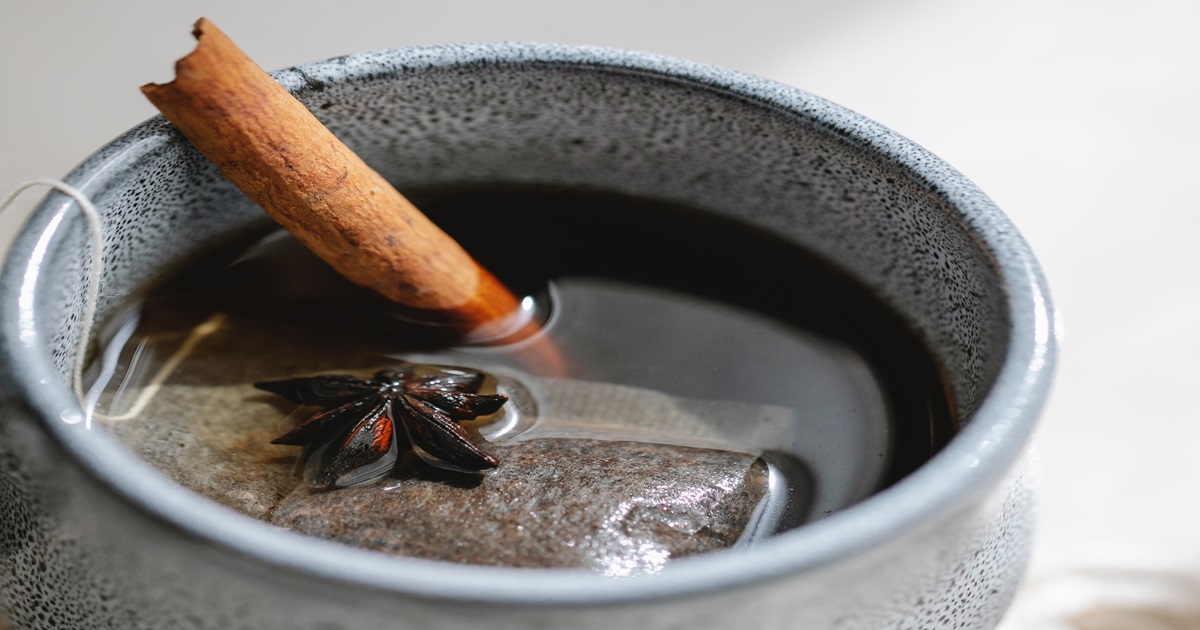
A Spice with Sweet Health Benefits: Unraveling the Potential of Cinnamon Tea for Blood Sugar Balance
Cinnamon tea, beyond its delightful and warming flavor, emerges as a healthful elixir with sweet benefits for blood sugar management. Join us as we delve into the intricate relationship between cinnamon tea and blood glucose levels, exploring how this aromatic spice may play a crucial role in reducing the risk of type 2 diabetes.
Cinnamon’s Active Compounds: The Blood Sugar Balancing Act
Polyphenols in Cinnamon Tea:
Cinnamon tea boasts a rich content of polyphenols, powerful antioxidants known for their health-promoting properties. These compounds, including catechins and procyanidins, contribute to the tea’s ability to combat oxidative stress in the body. Polyphenols play a vital role in neutralizing free radicals, supporting cellular health, and potentially reducing the risk of chronic diseases. By incorporating cinnamon tea into your routine, you harness the potent antioxidant effects of polyphenols, contributing to overall well-being.
Cinnamaldehyde in Cinnamon Tea:
Cinnamaldehyde is a key component in cinnamon responsible for its distinctive flavor and aroma. Beyond its sensory appeal, cinnamaldehyde exhibits potential health benefits. Studies suggest that this compound may contribute to blood sugar regulation by improving insulin sensitivity. Additionally, cinnamaldehyde has antimicrobial properties, potentially aiding in the prevention of bacterial and fungal infections. Enjoying cinnamon tea provides a flavorful way to incorporate cinnamaldehyde into your diet, reaping both its aromatic richness and potential health advantages.
Reducing the Risk of Type 2 Diabetes: Cinnamon Tea as a Preventive Measure
Exploring the Preventive Potential
Cinnamon tea exhibits promising potential as a preventive measure for type 2 diabetes, primarily attributed to its active compound, cinnamaldehyde. Here’s how:
Improving Insulin Sensitivity:
- Cinnamaldehyde may enhance insulin sensitivity, assisting cells in utilizing insulin more effectively. Improved insulin sensitivity helps regulate blood sugar levels, reducing the risk of insulin resistance, a precursor to type 2 diabetes.
Enhancing Glucose Metabolism:
- Studies suggest that cinnamon can aid in glucose metabolism. It may lower fasting blood sugar levels by slowing the absorption of glucose after meals, potentially preventing spikes that can contribute to diabetes development.
Anti-Inflammatory Properties:
- Chronic inflammation is associated with insulin resistance and diabetes. Cinnamon possesses anti-inflammatory properties that may mitigate inflammation, promoting a healthier metabolic environment.
Reducing Oxidative Stress:
- Cinnamon’s rich antioxidant content, including polyphenols, helps combat oxidative stress. By neutralizing free radicals, cinnamon may protect cells from damage, reducing the risk of diabetes-related complications.
Managing Weight:
- Maintaining a healthy weight is crucial for diabetes prevention. Cinnamon may support weight management by influencing satiety and potentially reducing the accumulation of visceral fat.
To leverage these potential benefits, consider incorporating cinnamon tea into a balanced, healthy lifestyle. It’s essential to consult with a healthcare professional before making significant dietary changes, especially for individuals with existing health conditions. Cinnamon tea should complement, not replace, other preventive measures such as a balanced diet, regular exercise, and regular health check-ups.
Managing Blood Glucose Levels: The Daily Ritual of Cinnamon Tea
Incorporating Cinnamon Tea into Your Wellness Routine
Discover practical ways to incorporate cinnamon tea into your daily wellness routine for effective blood sugar management.
Morning Elixir:
- Start your day with a warm cup of cinnamon tea. Brew it using a cinnamon stick or ground cinnamon for a flavorful morning elixir.
Mealtime Companion:
- Sip on cinnamon tea alongside meals. Its potential to slow down glucose absorption may contribute to better blood sugar management after eating.
Cinnamon Spice in Smoothies:
- Add a twist to your smoothies by infusing them with cinnamon tea. Brew the tea and use it as a liquid base for a nutrient-packed and blood sugar-friendly beverage.
Iced Cinnamon Tea:
- Enjoy a refreshing iced version by brewing cinnamon tea and refrigerating it. Add ice, a slice of lemon, and a touch of honey for a delightful cold beverage.
Cinnamon Tea Infused Oatmeal:
- Enhance your morning oatmeal by using cinnamon tea as the cooking liquid. This imparts a subtle cinnamon flavor to your breakfast while potentially aiding in blood sugar regulation.
Cinnamon Tea Chia Pudding:
- Create a healthful chia pudding by soaking chia seeds in brewed and cooled cinnamon tea. Top with fresh berries for a nutritious and blood sugar-friendly dessert or snack.
Afternoon Ritual:
- Make cinnamon tea your afternoon ritual. Brew a cup during your break to enjoy its potential benefits for blood sugar management.
Cinnamon Tea Latte:
- Create a comforting cinnamon tea latte by adding frothed milk to your brewed tea. Sprinkle a dash of cinnamon on top for an extra touch.
Bedtime Soother:
- End your day with a calming cup of cinnamon tea. Its potential to support blood sugar management makes it a soothing addition to your evening routine.
Cinnamon Tea Blends:
- Experiment with herbal blends by combining cinnamon tea with other beneficial herbs like chamomile or ginger for a wellness-boosting infusion.
Incorporating cinnamon tea into your daily routine offers not only a flavorful experience but also the potential to support effective blood sugar management. Always consult with a healthcare professional for personalized advice, especially if you have existing health conditions or are on medications.
Considerations and Caution: Cinnamon’s Prudent Guardianship
Understand considerations and precautions associated with cinnamon consumption. Always consult with a nutritionist or a medical doctor for dosage recommendations, potential interactions with medications, and the importance of balance when incorporating cinnamon tea into your diet. Approach the sweet benefits of cinnamon with informed and mindful guardianship.
Stress Relief in a Cup: Lavender Tea
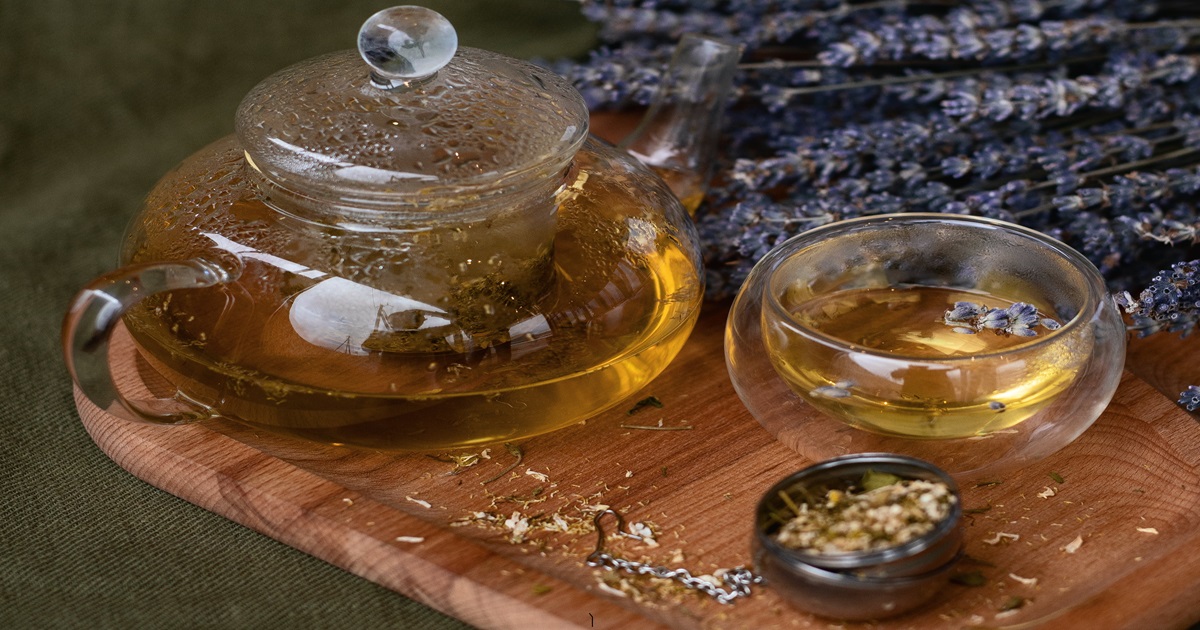
Unveiling the Stress-Relieving Elixir of Lavender Tea
Lavender tea originates from the fragrant purple blossoms of the Lavandula angustifolia plant, native to the Mediterranean region. Revered for centuries, this herbal infusion is celebrated for its calming effects, stemming from compounds like linalool. Known to promote relaxation, lavender tea aids in stress reduction and enhances sleep quality, making it a popular bedtime beverage. Beyond its soothing properties, the tea offers potential benefits for digestion, inflammation reduction, and mood enhancement. Its delicate floral notes and therapeutic qualities make lavender tea a cherished remedy, providing a calming respite in both taste and well-being.
The Essence of Lavender: Aromatherapy for the Soul
Lavender tea being one of the healthiest herbal teas has numerous health benefits. It’s aromatic magic makes it a powerhouse for stress relief. Let’s dive into the detailed health benefits of lavender tea:
- Calming and Relaxation: Lavender contains linalool and linalyl acetate, compounds known for their soothing properties. These aromatic molecules interact with neurotransmitters in the brain, promoting relaxation and reducing stress. Lavender may modulate gamma-aminobutyric acid (GABA) receptors in the brain. GABA is an inhibitory neurotransmitter that induces a calming effect. By enhancing GABA activity, lavender promotes a sense of tranquility. Lavender tea has been linked to a potential reduction in cortisol levels, which is a known as stress hormone associated with body’s fight or flight response.
- Improved Sleep Quality: Lavender has been traditionally used to address sleep issues. Consuming lavender tea before bedtime may help alleviate insomnia and promote better sleep quality, thanks to its sedative properties that relax the mind and body.
- Digestive Aid: Lavender tea can have a mild carminative effect, helping to soothe the digestive system. It may alleviate symptoms of indigestion, bloating, and gas, contributing to overall digestive comfort.
- Anti-Inflammatory Properties: Lavender tea is rich in antioxidants, including polyphenols. These compounds have anti-inflammatory effects that may help reduce inflammation in the body, potentially offering benefits for conditions related to inflammation.
- Headache and Migraine Relief: The analgesic and calming properties of lavender can contribute to headache relief. Drinking lavender tea or inhaling its aroma may offer a natural remedy for tension headaches and migraines.
- Mood Stabilization: The pleasant fragrance of lavender is associated with mood enhancement and stress reduction. Aromatherapy with lavender tea or simply enjoying a cup can positively impact mood, creating a more serene and balanced emotional state.
- Immune System Support: While not as potent as some other herbal remedies, lavender tea contains certain compounds with antimicrobial properties. These may provide mild support to the immune system, contributing to overall health.
Creative Combinations for Enhanced Relaxation
Explore the world of lavender tea blends, where creative combinations with other herbs and botanicals elevate the serenity quotient. From chamomile to lemon balm, discover how these blends not only enhance the flavor but synergistically contribute to a more profound sense of relaxation.
Chamomile Lavender Blend:
- Combine dried lavender flowers with chamomile for a double dose of relaxation. This blend is perfect for winding down in the evening.
Lavender Mint Infusion:
- Add fresh mint leaves to your lavender tea for a refreshing twist. This combination not only enhances the flavor but also contributes to a soothing experience.
Lemonade Lavender Elixir:
- Mix lavender tea with freshly squeezed lemon juice and a hint of honey for a calming lavender lemonade. Serve it chilled for a refreshing summer beverage.
Lavender and Green Tea Fusion:
- Blend lavender tea with green tea for a unique fusion. The combination of calming lavender and the subtle caffeine boost from green tea offers a balanced relaxation experience.
Vanilla Lavender Harmony:
- Infuse your lavender tea with a touch of vanilla extract for a soothing and aromatic combination reminiscent of a calming dessert.
Lavender Berry Bliss:
- Introduce dried berries like blueberries or raspberries to your lavender tea. The fruity notes complement the floral lavender, creating a delightful and relaxing infusion.
Ginger Lavender Serenity:
- Add a few slices of fresh ginger to your lavender tea for a mildly spicy and grounding combination. Ginger’s warmth complements lavender’s calming effects.
Lavender Rose Elegance:
- Combine dried rose petals with lavender for an elegant and aromatic tea. This blend not only promotes relaxation but also adds a touch of floral sophistication.
Honey Lavender Harmony:
- Enhance your lavender tea with a drizzle of honey. The natural sweetness of honey complements the floral notes of lavender, creating a harmonious and soothing beverage.
Lavender Lavender Latte:
- Create a lavender-infused latte by adding frothed milk to your brewed lavender tea. Sprinkle a pinch of dried lavender on top for an extra touch of relaxation.
Experimenting with these creative combinations not only enhances the flavor profile of your lavender tea but also provides a personalized and enjoyable ritual for enhanced relaxation. Adjust the ratios based on your taste preferences and savor the calming effects of these unique blends.
Incorporating Lavender Tea into Daily Self-Care Practices
Beyond the Teacup: Lavender’s Role in Self-Care
Learn how to incorporate lavender tea into your daily self-care practices. Incorporating lavender tea into your daily self-care practice can be a delightful and calming ritual. Here are some suggestions:
Morning Mindfulness:
- Start your day with a cup of lavender tea. Take a few moments to savor the aroma and sip mindfully, setting a calm tone for the day ahead.
Afternoon Reset:
- Brew a cup of lavender tea in the afternoon as a brief pause from work or daily activities. Use this time to relax, reflect, and recharge.
Aromatherapy Bath:
- Add brewed lavender tea or a few lavender tea bags to your bath. The warm water will release the soothing aroma, creating a spa-like experience at home.
Evening Wind-Down Ritual:
- Make lavender tea a part of your evening routine. Enjoy a cup as you unwind, signaling to your body that it’s time to transition into relaxation mode.
Bedtime Brew:
- Sip on a cup of lavender tea before bedtime. The calming properties of lavender can contribute to a more restful sleep, making it an excellent addition to your nighttime routine.
DIY Lavender Face Mist:
- Brew a strong batch of lavender tea, allow it to cool, and transfer it to a spray bottle. Spritz this lavender-infused mist on your face for a refreshing and calming skincare moment.
Meditation Companion:
- Integrate lavender tea into your meditation practice. Sip on the tea as you find stillness, enhancing the calming effects of both practices.
Journaling Session:
- Pair a cup of lavender tea with your journaling session. Let the soothing tea inspire introspection and self-reflection.
Lavender Tea Ice Cubes:
- Freeze lavender tea into ice cubes and add them to your water throughout the day. The subtle lavender flavor provides a refreshing twist.
Scented Pillowcase:
- Spritz a lavender tea mist on your pillowcase before bedtime. The calming aroma can create a serene atmosphere conducive to a good night’s sleep.
Lavender Tea – Sipping Serenity, One Blossom at a Time
It’s important to brew lavender tea with dried lavender flowers, ensuring that the source is suitable for consumption. While generally safe, individuals with allergies to the Lamiaceae family (which includes mint, sage, and basil) should use lavender with caution. As with any herbal remedy, moderation is advised, and consulting with a healthcare professional, especially for pregnant or nursing individuals, is recommended.
Conclusion: Embrace Wellness, One Sip at a Time
Healthiest Herbal teas are not only a delightful beverage choice but also a gateway to a healthier, more balanced life. With an array of flavors and potential health benefits, incorporating herbal teas into your routine is a simple yet powerful step towards overall wellness. Explore the world of herbal infusions, and let each sip be a celebration of health and vitality.
Frequently Asked Questions ->
Herbal teas, also known as tisanes (pronounced tih-SAHN), are beverages made by steeping herbs, spices, fruits, or flowers in hot water. Unlike true teas (black, green, white, etc.) which come from the Camellia sinensis plant, herbal teas are caffeine-free and boast a wide variety of flavors and potential health benefits.
There are countless herbal tea varieties, each with its unique flavor and aroma. Some popular types include:
Chamomile: Known for its calming and relaxing properties, chamomile tea is often enjoyed before bedtime.
Peppermint: Often used to soothe an upset stomach, peppermint tea also has a refreshing taste.
Ginger: Ginger tea is a popular choice for easing nausea and may also help boost the immune system.
Echinacea: Traditionally used to support the immune system, echinacea tea is commonly consumed during cold and flu season.
While scientific evidence is still emerging for many herbal teas, they have been used for centuries in various cultures for their potential health benefits. Some studies suggest that herbal teas may help with:
Relaxation and stress relief
Digestion and nausea
Colds and flu
Sleep quality
Inflammation
Herbal teas can be found in most grocery stores, health food stores, and online retailers.
While generally safe for most people, it’s important to consult with a healthcare professional before consuming herbal teas, especially if you are pregnant, breastfeeding, taking medications, or have any underlying health conditions.


